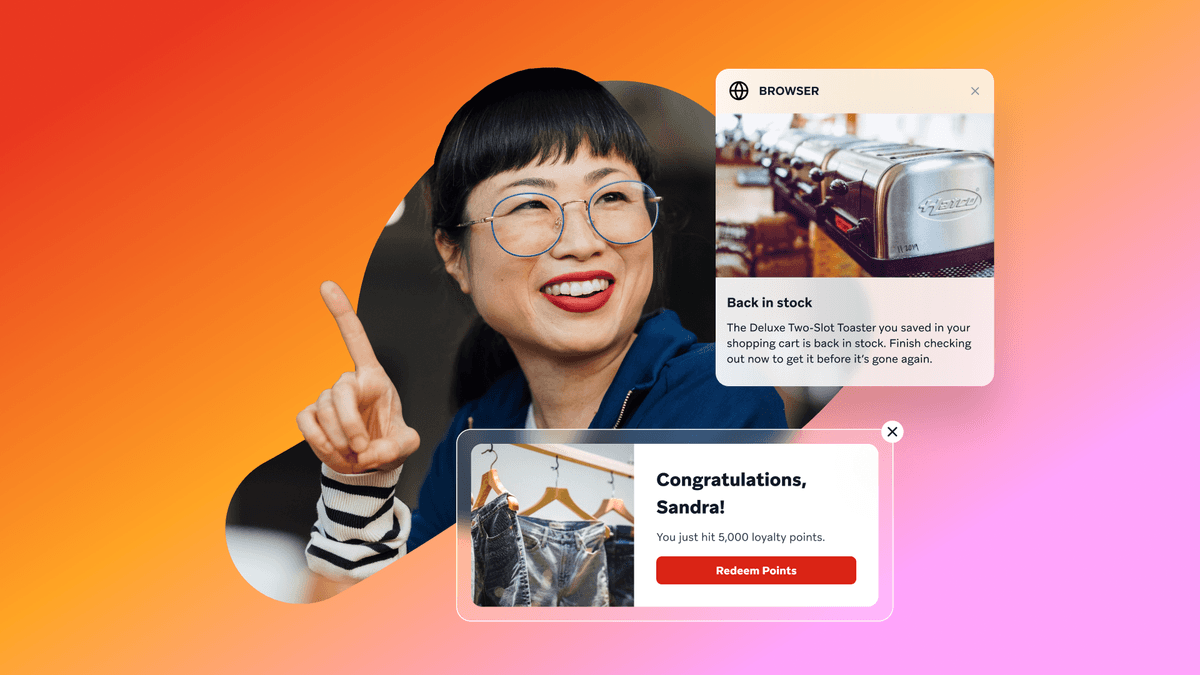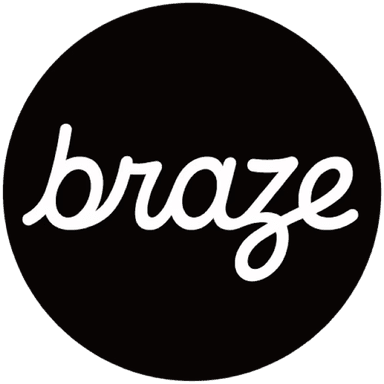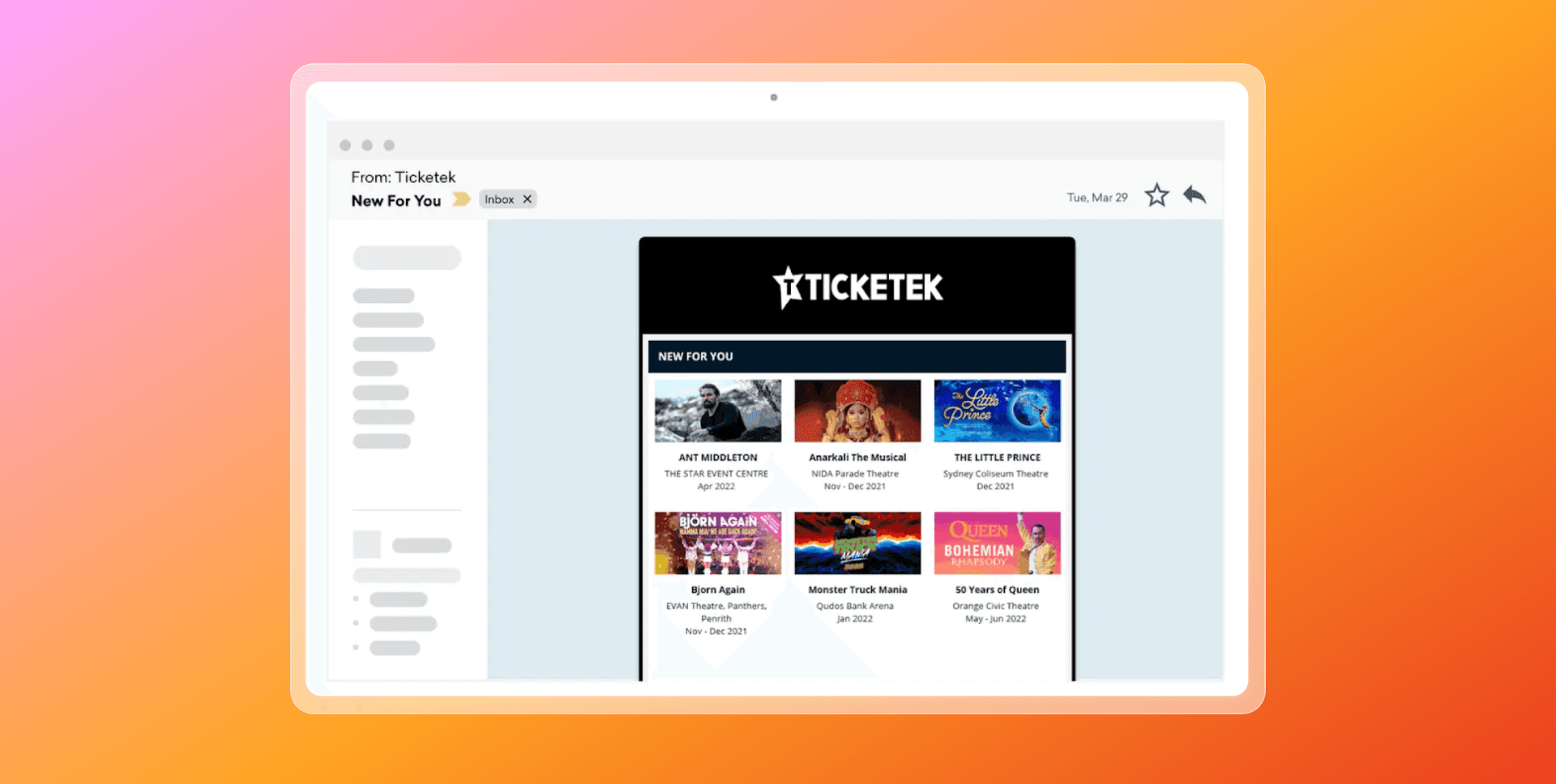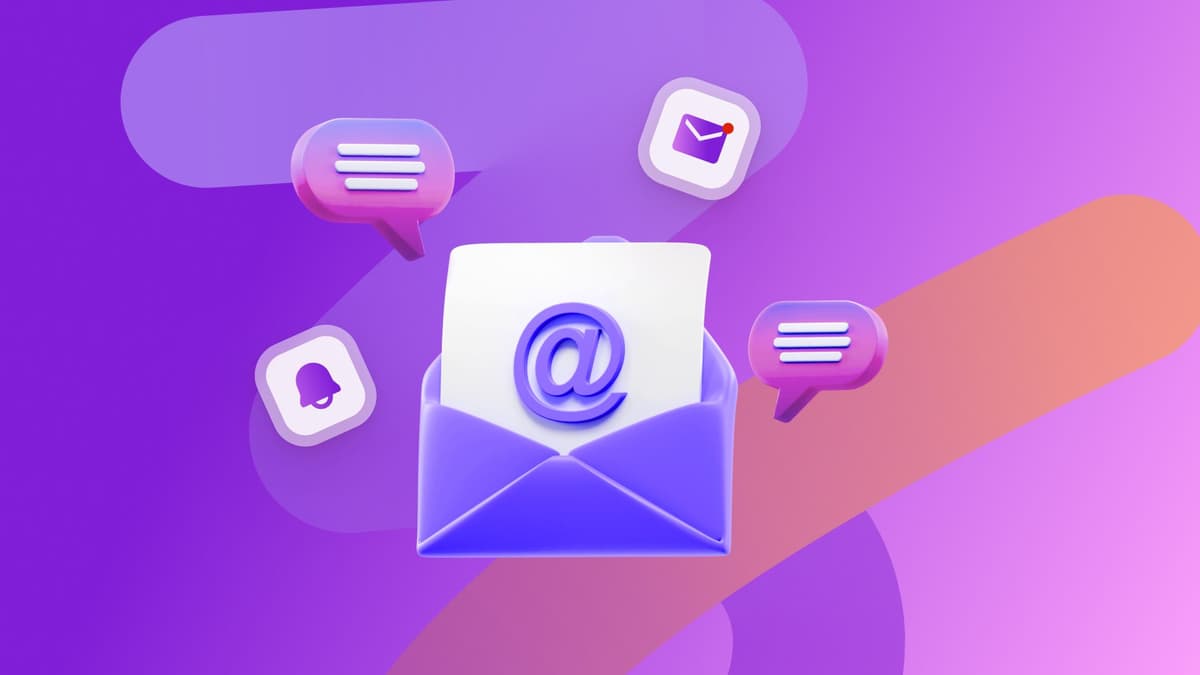Marketing automation examples: 10 real Campaigns that drive growth
Published on November 10, 2025/Last edited on November 10, 2025/16 min read


Team Braze
BrazeMarketing automation examples show how brands transform customer data into campaigns that drive measurable growth. From lead nurturing and onboarding to retention and win-back, automation connects channels like email, SMS, push, in-app, web, and paid ads into coordinated journeys that keep customers engaged.
In this guide, you’ll find 10 key types of automation, see how different industries apply them, and explore real-world case studies that prove their impact. Along the way, we’ll highlight how BrazeAI™ and BrazeAI Decisioning Studio™ help marketers optimize campaigns to increase retention, improve conversion rates, and grow customer lifetime value.
Contents
- What is marketing automation?
- Ten marketing automation examples
- Marketing automation in B2B vs. B2C
- Marketing automation workflow examples in practice
- Benefits of marketing automation
- How Braze supports marketing automation
- Final thoughts about marketing automation examples
- FAQs about marketing automation examples
What is marketing automation?
Marketing automation is the use of technology to streamline, personalize, and scale customer engagement. Rather than sending one-off campaigns, teams create automated workflows—like lead nurturing sequences, onboarding journeys, or re-engagement campaigns—that adapt to customer behavior in real time.
Marketing automation helps brands move from manual, repetitive tasks to coordinated programs that increase efficiency and impact.
10 marketing automation examples
There are many ways to bring automation into your marketing strategy. Below are 10 of the most common types of automation, showing how brands use data and customer behavior to engage customers across the lifecycle.
1. Lead nurturing workflows
Guide prospects from awareness to purchase with sequenced campaigns that build trust over time. These workflows can combine email, in-app messages, and retargeting ads to keep leads moving through the funnel.
Example use case: B2B nurture sequence
- Welcome email with helpful resources
- Case study spotlight
- Invitation to a product demo or webinar
- Follow-up in-app message nudging free trial sign-up
- Retargeting ad reinforcing value proposition
Lead nurturing workflows are designed to educate, build credibility, and keep your brand top of mind until a prospect is ready to convert. Nurtured leads produce a 20% increase in sales opportunities compared to non-nurtured leads.
Opportunity
You’ve captured interest from a new lead, but they aren’t ready to buy and risk going cold without consistent engagement.
Strategy
Build a staged workflow that delivers progressively deeper content. Start broad with educational resources, then introduce proof points like case studies, before finally offering conversion-focused nudges like demo invites. Use multiple channels to stay visible.
Outcome
Keep leads engaged through the buying journey, shorten sales cycles, and generate more sales-qualified opportunities.
2. Behavioral trigger campaigns
Send messages based on real actions—like browsing a product, using a feature, or abandoning checkout. Triggers make communications timely and relevant, improving engagement rates.
Example use case: Abandoned browse trigger
- User views a product page but leaves without adding to cart
- Trigger an email with “Still thinking it over?” and the product image
- Follow-up push notification with social proof or review snippet
- Dynamic recommendation for related products if original item sells out
Behavioral triggers respond to signals of intent in real time. Triggered emails are 59% more likely to be opened than time-based emails.
Opportunity
Your audience shows interest through browsing or feature use, but without a prompt they may never take the next step.
Strategy
Map common behaviors that signal intent (e.g., browsing, search, adding to cart, first purchase). Use those as triggers to deliver contextual nudges across email, push, or in-app. Keep the tone helpful rather than pushy.
Outcome
Increase relevance, improve engagement, and drive customers closer to conversion by connecting messages directly to their actions.
3. Drip campaigns
A series of scheduled messages designed to educate, convert, or upsell customers. Drip campaigns often support onboarding or deliver content over days or weeks.
Example use case: Educational drip series
- Day 1: Welcome email with introductory content
- Day 3: “How it works” explainer video
- Day 5: Case study or testimonial for credibility
- Day 7: Free trial or product demo invitation
- Day 10: Limited-time offer to drive conversion
Drip campaigns let you build a structured journey that unfolds at a steady pace. They allow marketers to deliver a narrative over time, keeping prospects engaged without requiring manual effort at each step.
Opportunity
Your prospects are curious but not yet ready to commit, and they need education and reassurance before taking the next step.
Strategy
Set up a pre-scheduled content journey with a mix of formats (guides, videos, social proof). Keep each message short and actionable, with a clear path to conversion. Layer in segmentation to adjust cadence or content type based on engagement.
Outcome
Build trust through consistent communication, gradually warm up leads, and improve conversion rates by moving people smoothly from awareness to decision.
4. Onboarding flows
Help new customers find value quickly. SaaS brands might spotlight product features, while ecommerce or QSR businesses guide first purchases or loyalty enrollment.
Example use case: Onboarding campaign
- Account creation confirmation
- Welcome message (email + push)
- Product education content (“How to get started”)
- Personalized tips based on profile/preferences
- Incentive to drive first purchase or key action
- In-app prompt to rate or explore features
Onboarding is the process of moving a newly acquired user from sign-up to their first meaningful action, which is essential for sustainable growth.
Opportunity
You’re acquiring new users, but many leave without completing a first purchase or exploring your product.
Strategy
Build a structured onboarding flow that combines welcome messages, educational content, and in-product prompts. Use channels like email, push, and in-app messages to reinforce your value proposition and encourage the first key action.
Outcome
Accelerate activation by guiding customers to your most engaging content and features, improving retention and lifetime value from the start.
5. Re-engagement campaigns
Reach out to customers who have gone quiet with targeted offers or reminders. These workflows include win-back emails, push notifications, or loyalty rewards that reignite interest.
Example use case: Win-back series
- 30 days inactive → “We miss you” email with product updates
- 45 days inactive → Push notification with personalized recommendation
- 60 days inactive → Incentive test (discount vs. loyalty points)
- 75 days inactive → Final reminder with urgency or exclusivity
Re-engagement campaigns are designed to remind inactive customers of your value before they churn permanently. Research has shown that customer win-back campaigns typically achieve open rates around 12%. While conversion rates differ by industry, even small lifts can deliver meaningful impact when aimed at high-value users.
Opportunity
A significant portion of your user base becomes inactive over time, risking churn and lost revenue.
Strategy
Create a staged workflow that escalates value: start with reminders, then move to personalized recommendations, and finally test incentives to prompt return engagement. Vary the channel to avoid fatigue.
Outcome
Reignite interest among dormant users, recover revenue, and extend customer lifetime value by preventing churn.
6. eCommerce automation
From abandoned cart flows to replenishment reminders and predictive send-time campaigns, ecommerce automation is designed to maximize conversion and lifetime value.
Example use case: Abandoned cart + replenishment flow
- Cart abandoned → Reminder email within 1 hour
- Follow-up push notification with product image
- Incentive test (discount vs. free shipping)
- Replenishment reminder 30 days post-purchase
- Predictive send-time optimization for follow-ups
An analysis of 50 different studies found an average cart abandonment rate of 70.22%. With such a large share of potential purchases left unfinished, recovery and replenishment campaigns make ecommerce automation one of the highest-return opportunities.
Opportunity
Customers show intent by adding items to a cart or by purchasing replenishable goods, but without a prompt they often fail to convert or repurchase.
Strategy
Use behavioral triggers for cart recovery and replenishment, and layer in predictive send-time optimization to deliver messages when customers are most likely to respond. Test incentives, but don’t over-discount—value-based nudges often work just as well.
Outcome
Recover lost revenue, improve conversion rates, and increase lifetime value through timely, contextual, and personalized eCommerce automations.
7. Cross-sell and upsell campaigns
Recommend complementary products or higher-tier services based on purchase history or usage patterns. These can be delivered via email, push, or in-app prompts.
Example use case: Post-purchase upsell flow
- Purchase completed → Order confirmation email with recommended add-ons
- 7 days later → Push notification suggesting complementary product
- 14 days later → Email highlighting premium upgrade with benefits
- In-app prompt during next login offering bundle discount
Cross-sell and upsell campaigns increase revenue by expanding the value of each customer relationship. Cross-selling can boost sales by 20% and profits by 30%.
Opportunity
Customers who’ve already purchased or engaged are more open to considering related products or higher-value services.
Strategy
Analyze purchase history or usage behavior to identify logical next products or upgrades. Use post-purchase touchpoints like confirmation emails or account logins to introduce these offers without disrupting the customer experience.
Outcome
Grow average order value, increase customer lifetime value, and deliver more relevant experiences that feel helpful rather than pushy.
8. Retention and loyalty programs
Celebrate milestones, reward repeat purchases, and keep loyal customers engaged through automated messaging across multiple channels.
Example use case: Loyalty milestone journey
- Customer reaches 3rd purchase → Trigger “Thank you” email with loyalty points update
- 6 months active → Push notification with exclusive reward offer
- 12 months active → Anniversary message with special discount
- Surprise bonus for high-value customers (email + in-app message)
72% of customers are more likely to recommend a brand if it has a strong loyalty program.
Opportunity
You have a base of repeat customers, but without ongoing recognition they may feel undervalued and drift to competitors.
Strategy
Set up milestone triggers (purchases, anniversaries, tenure) and reward loyal customers through points, perks, or exclusive offers. Use email for updates, push for timely rewards, and in-app for seamless redemption.
Outcome
Increase retention, reduce churn, and transform satisfied customers into advocates who engage more often and spend more over time.
9. Cross-channel orchestration
Coordinate messaging across email, SMS, push, in-app, WhatsApp, web, and paid ads to create consistent journeys that adapt to each customer’s context.
Example use case: Product launch campaign
- Launch announcement email to subscriber base
- Push notification for app users highlighting the new feature
- In-app message walking users through benefits on first login
- SMS reminder for opted-in customers after 3 days
- Retargeting ads for those who haven’t engaged after a week
Analysis shows that combining in-product and out-of-product channels drives 25% more purchases per user than relying on out-of-product channels alone—and 6.5 times more purchases than using only in-product channels.
Opportunity
Customers interact with your brand in multiple places, but siloed campaigns risk sending mixed messages—or too many.
Strategy
Use an orchestration tool to plan journeys that coordinate timing, channel, and message sequencing. Apply frequency caps and preference data to respect customer boundaries while maintaining reach.
Outcome
Create cohesive brand experiences across touchpoints, increase engagement, and improve ROI by unifying campaigns into a single, customer-centric journey.
10. Customer lifecycle marketing
Bring it all together with campaigns that span acquisition, onboarding, engagement, retention, and win-back—delivering personalization at scale to grow customer lifetime value.
Example use case: Full lifecycle journey
- Acquisition: Paid ad → Welcome email with sign-up incentive
- Onboarding: In-app walkthrough highlighting key features
- Engagement: Personalized product recommendations via email and push
- Retention: Loyalty milestone rewards and exclusive offers
- Win-back: Re-engagement email with incentive after 60 days inactive
Experience-led growth strategies that raise customer satisfaction by 20% or more deliver measurable impact across the lifecycle. They can lift cross-sell rates by 15-25% during the engagement phase, expand share of wallet by 5-10% at the retention stage, and drive 20-30% improvements in satisfaction and engagement that strengthen long-term loyalty.
Opportunity
You’re running campaigns, but they operate in silos and don’t create a continuous experience.
Strategy
Map the full customer journey and build connected workflows for each stage. Use personalization at scale to tailor messaging, and orchestrate across channels to maintain consistency.
Outcome
Strengthen engagement at every stage, increase retention, and maximize lifetime value by treating customers as part of an ongoing relationship rather than a one-time transaction.
Marketing automation in B2B vs. B2C
Different industries lean on different types of marketing automation depending on their goals and customer journeys. While the tools and tactics are similar, how they’re applied varies between B2C, B2B, and SaaS.
B2C
Brands in ecommerce, retail, QSR, and media use automation to drive frequent transactions and loyalty. Common workflows include abandoned cart recovery, cross-sell and upsell campaigns, retention and loyalty programs, and cross-channel orchestration to coordinate offers across email, SMS, push, and ads.
B2B marketing automation examples
Automation in B2B often focuses on longer sales cycles and complex decision-making. Common B2B marketing automation examples include lead nurturing workflows, drip campaigns, and demo invitations, which help guide prospects through the funnel. Behavioral triggers can also help sales teams act on signals of intent, such as content downloads or pricing page visits.
SaaS
For SaaS businesses, automation centers on onboarding, product adoption, and retention. Flows often highlight key features, encourage usage during free trials, and prompt upgrades to paid or higher-tier plans. Campaigns like feature adoption nudges or churn prevention programs are especially important.
By aligning automation with the dynamics of each industry, marketers can meet their customers where they are and use the right mix of workflows to maximize engagement and long-term value.
Marketing automation workflow examples in practice
Real-world campaigns show how automation works across different industries and objectives. Here are three examples of brands using Braze to orchestrate workflows that drive measurable growth in B2C, B2B, and SaaS.
Ticketek: Personalization at scale in live entertainment (B2C)
Ticketek is a global leader in ticketing services, connecting fans with live events across 20+ markets.
The challenge
Re-engage fans with relevant event recommendations at scale, while reducing the manual effort needed to manage complex campaigns.

The workflow
Ticketek used Braze to build automated journeys that combined customer data with behavioral triggers. Fans received personalized recommendations across email and push based on past ticket purchases, favorite teams, and artists.
The results
- 3.3x increase in conversions compared to non-personalized campaigns
- Significant reduction in campaign build times
- Global scalability without losing relevance
BEES (AB InBev): Driving B2B digital adoption
BEES, AB InBev’s global B2B ordering platform, connects retailers and distributors in 20+ countries with tools to simplify ordering and grow their businesses.
The challenge
Accelerate digital transformation and adoption of the BEES app among a diverse, international B2B audience.
The workflow
By integrating Segment with Braze, BEES created automated onboarding and engagement flows for B2B users. Push notifications reminded retailers to place orders, while drip campaigns introduced new features and personalized recommendations helped boost profitability.
The results
- Millions of B2B users engaged regularly on the BEES platform
- Higher order frequency and consistency among retailers
- Stronger partner relationships supporting AB InBev’s global growth
Canva: Personalized product adoption at scale (SaaS)
Canva is a global design platform empowering millions of users—individuals, teams, and enterprises—to create visual content.
The challenge
Increase adoption of Canva’s wide-ranging product catalog and helps users discover the most relevant features for their needs.

The workflow
Using Braze Catalogs, Canva built personalized onboarding and feature education campaigns. Automated emails, in-app messages, and push notifications highlighted templates, tools, and integrations tailored to each user’s goals and behaviors.
The results
- Higher adoption of Canva’s diverse product features
- Improved user engagement and satisfaction across segments
- Scalable personalization for millions of users globally
Benefits of marketing automation
Marketing automation gives brands the ability to scale personalized engagement while improving efficiency. The impact spans both internal workflows and customer outcomes.
Increased efficiency and reduced manual work
Automated workflows eliminate repetitive tasks like sending follow-ups or segmenting audiences manually. Teams can focus on strategy and creativity instead of day-to-day execution.
Higher engagement, conversions, retention, and CLV
By sending messages at the right time and in the right channel, automation improves click-throughs and conversion rates. Over time, this strengthens retention and increases customer lifetime value.
Consistent brand voice across channels
Cross-channel orchestration allows marketers to maintain a unified voice, whether they’re reaching customers via email, SMS, push, in-app, or paid media.
Scalable personalization
Automation powered by customer data makes it possible to personalize at scale—recommending products, tailoring content, and timing messages for millions of users without losing relevance.
How Braze supports marketing automation
Braze makes it possible to design, test, and optimize automation across every stage of the customer lifecycle and every major channel—all from a single platform.
Drag-and-drop journey orchestration
Build sophisticated customer journeys visually, without relying on engineering resources. With Braze Canvas Flow, marketers can combine triggers, delays, and decision splits in an intuitive interface to move customers seamlessly through their lifecycle.
Cross-channel campaign execution
Reach customers on the channels they use most—including email, SMS, push, in-app, WhatsApp, web, and even ads. Braze enables you to coordinate campaigns across these touchpoints for a consistent brand experience.
AI-powered personalization
Deliver smarter, more relevant messages at scale. BrazeAI™ supports personalization, send-time optimization, and recommendations to increase engagement and conversions.
Continuous optimization with reinforcement learning
Take automation further with BrazeAI Decisioning Studio™. This reinforcement learning engine continuously tests and adapts campaigns, selecting the best message or offer for each customer.
Governance and compliance controls
Protect trust and avoid fatigue with built-in frequency caps, guardrails, and consent management features that keep campaigns compliant and respectful of customer preferences.
Final thoughts about marketing automation examples
Marketing automation is now a cornerstone of customer engagement. It gives marketers the ability to anticipate needs, personalize at scale, and sustain growth across industries.
For retailers, that might mean recovering carts or encouraging repeat purchases. For B2B, it’s guiding leads through longer buying cycles. For SaaS, it’s driving adoption and customer retention through product education. Whatever the use case, the outcome is the same—more relevant experiences that strengthen relationships and increase customer lifetime value.
With Braze, marketers can design and orchestrate these journeys across channels, apply AI to optimize them continuously, and turn automation into a long-term driver of engagement and growth.
FAQs about marketing automation examples
What are examples of marketing automation?
Examples of marketing automation include lead nurturing workflows, onboarding journeys, re-engagement campaigns, cart recovery, and upsell and cross-sell campaigns.
What are common marketing automation workflows?
Common marketing automation workflows include onboarding flows, lead nurturing, re-engagement campaigns, cart recovery, and cross-sell or upsell programs.
How does marketing automation improve customer engagement?
Marketing automation improves customer engagement by sending relevant, timely messages that keep users active and build stronger connections.
What’s the difference between B2B and B2C marketing automation examples?
The difference between B2B and B2C marketing automation examples is in focus. B2B centers on lead nurturing and demos, while B2C emphasizes cart recovery, loyalty programs, and repeat purchases.
What are the benefits of marketing automation campaigns?
The benefits of marketing automation campaigns include reduced manual work, higher engagement, increased conversions, and scalable personalization.
How do Braze and BrazeAI™ help with marketing automation?
Braze and BrazeAI™ help with marketing automation by enabling cross-channel orchestration, personalization, send-time optimization, and continuous campaign improvement.
What channels can be included in marketing automation?
Channels that can be included in marketing automation are email, SMS, push, in-app, WhatsApp, web, and paid media.
How can I use marketing automation to improve retention and CLV?
You can use marketing automation to improve retention and CLV with onboarding campaigns, loyalty rewards, milestone journeys, and churn-prevention workflows.
Related Tags
Be Absolutely Engaging.™
Sign up for regular updates from Braze.
Related Content
View the Blog
Adapting to change: How startups can stay agile in a rapidly evolving market

Team Braze

Digital body language: The startup growth multiplier

Team Braze

Understanding email open rates and how to improve them
